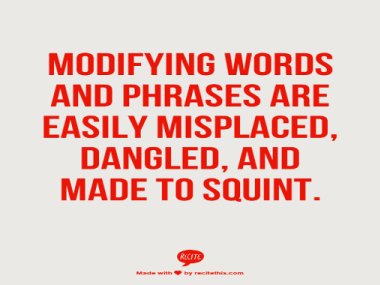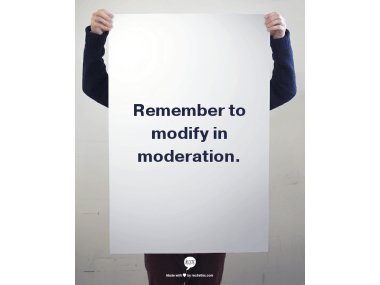‘Only’: The Most Insidious Misplaced Modifier
How putting the word “only” in the wrong place can confuse your readers.

Monday is March 4: National Grammar Day! Of course, every day is Grammar Day as far as I’m concerned, but it’s nice to have a nationally recognized day when grammar enthusiasts can be as grammar-geeky as they want. For my international listeners, you have my permission to consider today International Grammar Day, and share interesting facts about the grammars of any language you know. In recognition of such a grammaracious occasion, today’s topic is one that the late journalist and grammarian James Kilpatrick covered in an annual column: the placement of “only.”
For years, Kilpatrick would devote a column in January to the placement of the adverb “only,” illustrating his point with a sentence like “John hit Peter in the nose.” (1, 2) He would draw his readers’ attention to the differences in meaning between these four versions of the sentence:
- Only John hit Peter in the nose.
- John hit only Peter in the nose.
- John hit Peter only in the nose.
- John only hit Peter in the nose.
Sponsor: Audible.com, the Internet’s leading provider of audiobooks with more than 100,000 downloadable titles across all types of literature, including fiction, non-fiction and periodicals. For a free audiobook of your choice, go to audiblepodcast com.
Put the Adverb ‘Only’ as Close as Possible to What It Modifies
His point was that you need to put the adverb “only” as close as possible to the word it modifies. The sentence “Only John hit Peter in the nose” means that John hit Peter in the nose, and no one else did. The sentence “John hit only Peter in the nose” means that John hit Peter in the nose, and didn’t do that to anybody else. The sentence “John hit Peter only in the nose” means that John hit Peter in the nose, not in or on any other part of his body.
Some Placements of the Adverb ‘Only’ are Inherently Confusing
That brings us to the last sentence: “John only hit Peter in the nose.” In this case, the advice about putting “only” as close as possible to the word it modifies might not be enough to make your meaning clear. “John only hit Peter in the nose” can have at least two meanings. It could mean that John hit Peter in the nose, and didn’t do anything else. He didn’t trip him, call him names, or put a “Kick Me” sign on his back. On the other hand, if I say, “John only hit Peter in the nose,” I mean that John hit Peter in the nose, and did not do anything else to Peter’s nose. He didn’t pinch it, kick it, or kiss it.
Adverbs Can Modify Words or Whole Phrases
What’s going on? Where is this meaning difference coming from? The confusion comes from the assumption that “only” always modifies just a word. In fact, it can also modify entire phrases. If I say, “John only hit Peter in the nose,” without stressing any particular word in the verb phrase “hit Peter in the nose,” then “only” can modify that entire phrase. In that case, we mean that hitting Peter in the nose is the only thing John did. No tripping, calling names, or for that matter, riding a bicycle or listening to podcasts.
If I say, “John only hit Peter in the nose,” then “only” is modifying just the verb “hit.” That is, of all the things John could have done to Peter’s nose, hitting is what he did. The stress tells us which specific word in the verb phrase “only” is modifying.
Stress Can Show What Word or Phrase Adverbs Modify
If we recognize that stress can play an essential part in determining what “only” means, that raises some interesting possibilities. We could just put the “only” before “hit Peter in the nose” and use stress to make all the meaning distinctions. That is, we could say “John only hit Peter in the nose” to mean that he hit Peter and no one else. We could say, “John only hit Peter in the nose,” to mean that he hit Peter’s nose and no other part of his body. The trouble is, stressing a word works better in spoken English than in written English. In written English, it’s still better to put “only” as close to the word or phrase that it modifies, and just recognize that even doing that won’t always eliminate ambiguity. You’ll still need to ask yourself if the sentence could be misunderstood, and find some other way to make it clear if necessary.
Stress even plays a role in one of the earlier versions of the “John hit Peter” sentence. In the “John hit Peter only in the nose,” the “only” is reaching inside the prepositional phrase “in the nose” to modify just “nose.” The reason we might write “only in the nose” instead of “in only the nose” is because the context makes it clear that “nose” is the relevant word. But if for some reason we had to distinguish between John hitting Peter in the nose, above the nose, below the nose, or around the nose, then we’d have to stress the word “in” to show that it was the relevant word, not “nose”: “John hit Peter only in the nose.”
Now that we’ve seen examples of “only” reaching inside verb phrases and prepositional phrases to modify the relevant word, here’s an example with a noun phrase. I was at the barber shop one day, getting my hair cut by Lisa. Lisa was joking around with the other barbers, Ralph, Greg, and Danny, about why their fellow barber Howard wasn’t in that day. Danny said, “Only the manly men came in today.”
But wait—Lisa isn’t a manly man! She isn’t even a man! How could Danny’s wise-guy remark pack any punch with such an obvious mistake? The answer is that “only” wasn’t modifying the entire noun phrase “the manly men”; it was reaching inside that noun phrase to modify just the adjective “manly.” In this example, there’s not even a possibility of putting “only” next to the word it modifies. If Danny had said, “The only manly men came in,” that still would allow the possibility that the unmanly men had come in, too, which is exactly what he was trying to rule out. How did Danny make sure the “only” was modifying just “manly”? By putting the stress on the word “manly.”
Context Matters When Placing Adverbs
To sum up, you should definitely try in written English to put “only” as close as possible to the word or phrase it modifies. However, be aware that doing this won’t eliminate every possible ambiguity. You have to rely on context, and if the context doesn’t make things clear enough, you may still need to rephrase to clarify. Conversely, don’t insist at all costs on precise placement of “only.” If the context makes your meaning clear, then let the rhythm of the sentence tell you where to put the “only.”
This podcast was written by Neal Whitman, who blogs about linguistics at literalminded.wordpress.com and is a regular columnist for the online resource Visual Thesaurus.
References
-
Kilpatrick, J. “If we could only get this one right.” Eugene Register-Guard. January 14, 2007. Click here for more information (accessed February 28, 2013).
-
Kilpatrick, J. “Perspective: In praise of ‘only,’ but place it in the right place.” St. Augustine.com. January, 20, 2003. https://staugustine.com/stories/012003/opi_perp.shtml (accessed February 28, 2013).
You May Also Like…




